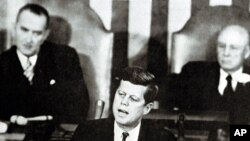Fifty years ago, on May 25, 1961, U.S. President John F. Kennedy issued a grand challenge that changed the world as humankind knew it - to send a man to the moon and bring him home again, and to do it by the end of the decade.
It is one of the most enduring images of all time - an earthling setting foot upon the moon for the first time. The moment was immortalized by astronaut Neil Armstrong.
"One small step for [a] man, one giant leap for mankind," he said.
The challenge to put a man on the moon had been issued only eight years earlier, on May 25, 1961, by newly elected President John F. Kennedy in a bold speech before Congress.
"First, I believe that this nation should commit itself to achieving the goal, before this decade is out, of landing a man on the moon and returning him safely to the earth," he said.
To set the stage for this speech, here is a bit of history:
In 1957, the Soviet Union launched Sputnik - the first artificial object ever placed into orbit around Earth.
And only one month before Kennedy's speech, the Soviets sent the first man into space, Yuri Gagarin.
Three weeks later an American followed suit - Alan Shepard, who admired the view from his Freedom 7 Mercury space capsule.
"On the periscope - what a beautiful view," said Shepard. "Cloud cover over Florida."
The space race was well underway.
Allan Needell, who works at the Smithsonian Air and Space Museum in Washington, where he curates the lunar-mission spacecraft collection, says attaining technological superiority in the space race was also about swaying new nations on Earth.
"The Soviet Union was providing a real challenge to American supremacy, and the fear was that most of these emerging countries, both in Latin America and in Asia, would choose the model of the [Communist] Soviet system rather than the free market, capitalist system that was favored by the United States," he said.
At the time of Mr. Kennedy's speech, there were also issues at home.
"It was the end of a recession, a recession which by recent standards wasn't as severe as the one we're just passing, but it was severe in the context of the 1950s, which had been a period of quite dramatic growth," said Needell.
There was also high unemployment and a number of aging Americans who could not afford adequate healthcare - challenges similar to those the country faces today.
Recently, President Barack Obama recalled the early days of the space race.
"After investing in better research and education, we didn't just surpass the Soviets; we unleashed a wave of innovation that created new industries and millions of new jobs," he said.
That wave of innovations sent men to the moon.
Other presidents have set out grand challenges for space innovation, such as Ronald Reagan in 1984.
"We can follow our dreams to distant stars, living and working in space for peaceful, economic and scientific gain," President Reagan said. "Tonight, I am directing NASA to develop a permanently manned space station and to do it within a decade."
It took a little longer than planned, but people have lived continuously on the International Space Station for the past decade, and the ISS is seen as an advancement for all mankind.
Needell says that was also the case with the first moon landing.
"The vision of this being 'we come in peace for all mankind' was developed and actually accepted all around the world, that this was a human accomplishment as much as it was a demonstration of American superiority," he said.
And a giant leap for mankind.












